$790.00 – $890.00Price range: $790.00 through $890.00
The grid test is a straightforward, cost-effective method commonly employed to assess long-term behavioral deficits in mice, particularly in Parkinson’s research. Several versions of the test exist, and various modifications are available to facilitate video-based grading. MazeEngineers provides the standard grid test in two forms: the traditional horizontal grid test and a vertical grid test variant.

MazeEngineers empowers preclinical neuroscience research with meticulously designed, customizable behavioral apparatuses. From manual classic mazes to fully automated smart systems, we provide the tools scientists need to capture high-quality, reproducible data for studies on learning, memory, anxiety, and depression.
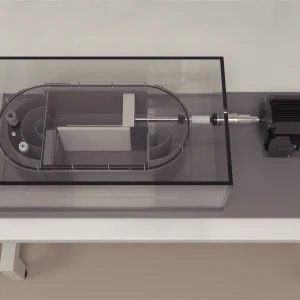
bool(false)
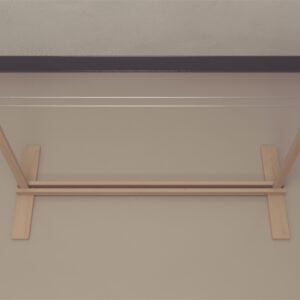
bool(false)
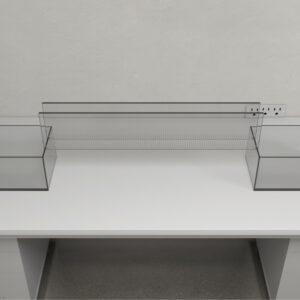
Version 1 |
32 cm x 20 cm x 50 cm (L x W x H) |
Openings: 1.1 x 1.1 cm diameter openings |
Version 2 |
41 cm x 41 cm x 41 cm (L x W x H) |
Each grid cell 3.5×3.5 cm |

The Grid test is employed to assess neuromuscular strength and coordination in rodents and is frequently used in conjunction with other assessments, such as the Rotarod and Gait test. Initially utilized by Tillerson et al. in 2002 to examine motor deficits in a murine model of Parkinson’s disease, the Grid test has evolved. Kim et al. modified the original design in 2010 by replacing the rods with clear plexiglass, facilitating easier data scoring. There are two primary versions of the Grid test: the Vertical Grid test and the Horizontal Grid test. These variants feature grid mesh positioned at fixed 90-degree angles relative to the surface.
The Grid test evaluates muscular strength by measuring the rodents’ ability to cling to the inverted mesh and assesses motor coordination through their locomotion in this inverted position. Since motor deficits are a key behavioral symptom of Parkinson’s disease, the Grid test is valuable for detecting subtle behavioral impairments in rodent models of the condition.
The Horizontal Grid apparatus, as described by Tillerson et al. (2002) and Tillerson and Miller (2003), features a 12 x 12 cm mesh with grid openings measuring 0.5 x 0.5 cm. The grid is elevated 20 cm above the surface to prevent the subjects from jumping off. It is enclosed by 3-inch high walls made of durable, opaque plexiglass, which do not interfere with the subject’s performance. Additionally, a bar crosses the grid’s width at its center and is connected to poles on each side, enabling the grid to be rotated.
No prior training is required for the task. The procedure involves lifting the rodent by its tail and positioning it in the center of the grid. Once the rodent has securely grasped the mesh with all four paws, its tail is released. The grid is then flipped upside down, and the subject is monitored for 30 seconds while it hangs from the inverted mesh. Trials are conducted as needed to ensure reliable results.
The subjects were administered L-DOPA post 28 days of either 7.5 or 15 mg/kg MPTP injection, and their performance was evaluated on the Horizontal Grid test. A significant improvement on step distance scores for both MPTP dosages was observed in comparison to the pre-L-DOPA scores. Further, a significant decrease in percentage wall time was also observed on treatment with L-DOPA. (Tillerson and Miller, 2003)
The subjects were administered either 7.5 or 15 mg/kg MPTP injections and their behavioral performance was evaluated on the Grid test. A sustained decline in step length of the MPTP subjects was observed over the course of 30 days. In comparison to the controls, the MPTP treated subjects showed an overall increase of percentage wall time and an increase in forepaw faults on the grid (Tillerson and Miller, 2003).
The following data can be collected during the Horizontal Grid test.
Step distance (grids covered/step) = √ (width)2+(length)2
The following sample graphs show the comparison of Grid Test measures of subjects treated with different doses of MPTP before and after administration of L-DOPA
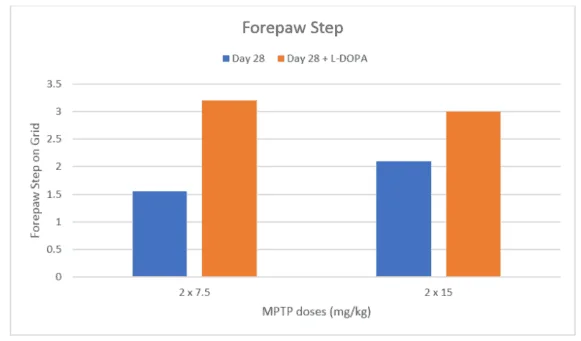
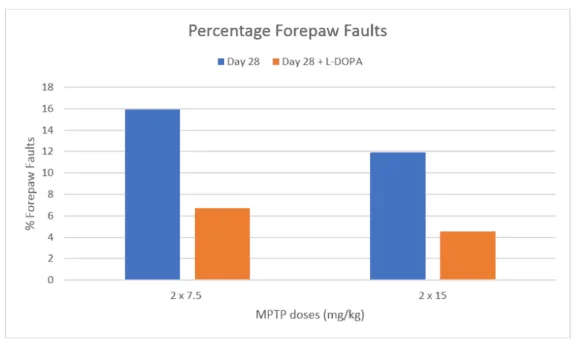

The following sample graph shows the variation of Percentage Contact Wall score across the test days.
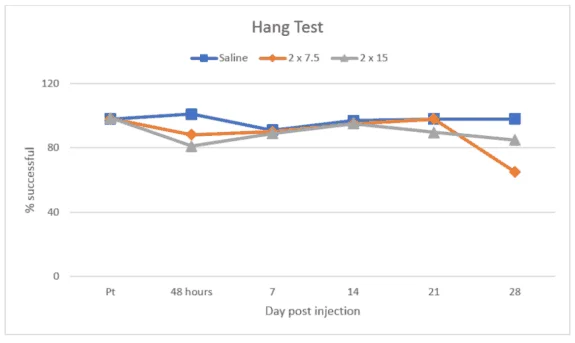
The sample graph below shows the Percentage of the Successful Hangtest score of two groups treated with two different dosages of MPTP and saline-treated subjects.
The Grid test is highly effective for evaluating neuromuscular strength and motor coordination in rodent models of Parkinson’s disease. It is also applicable for assessing motor performance in various other rodent models. Unlike the Vertical and Horizontal Grid tests, the Grid test accommodates a broader range of inclinations. This makes it particularly useful for detecting muscular dysfunction and assessing the impact of pharmacological treatments. Additionally, the test can be adapted to study age-related neuromuscular decline and to investigate nerve regeneration or damage.
Performing multiple trials using the Grid test may lead to muscle fatigue in the subjects. Additionally, the performance of the subjects can be influenced by their weight, so having a sizable group of subjects with similar weights is crucial for obtaining consistent results. Rest periods between trials are necessary to mitigate fatigue and ensure accurate measurements. Other factors, such as the subject’s age and sex, may also impact performance. Furthermore, the rod that crosses the grid could complicate the assessment of motor deficits.
Kim ST, Son HJ, Choi JH, Ji IJ, Hwang O (2010). Vertical grid test and modified horizontal grid test are sensitive methods for evaluating motor dysfunctions in the MPTP mouse model of Parkinson’s disease. Brain Res. 1306:176-83. doi: 10.1016/j.brainres.2009.09.103.
Tillerson, J.L., Caudle, W.M., Reverson, M.E., Miller, G.W., (2002). Detection of behavioral impairments correlated to neurochemical deficits in mice treated with moderate doses of 1-methyl-4-phenyl-1,2,3,6-tetrahydropyridine. Exp. Neurol. 178, 80–90.
Tillerson, J.L., Miller, G.W., (2003). Grid performance test to measure behavioral impairment in the MPTP-treated mouse model of parkinsonism. J. Neurosci. Methods 123, 189–200.
| Version | Version 1, Version 2 |
|---|
There are no questions yet. Be the first to ask a question about this product.